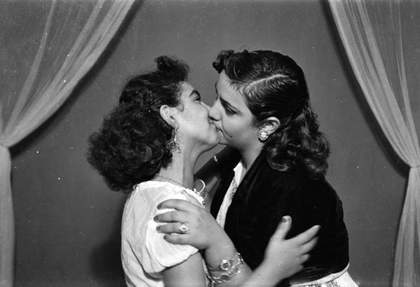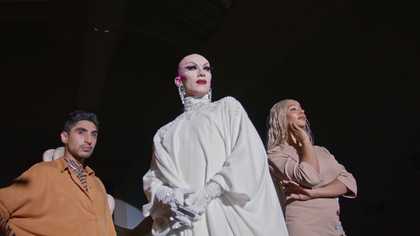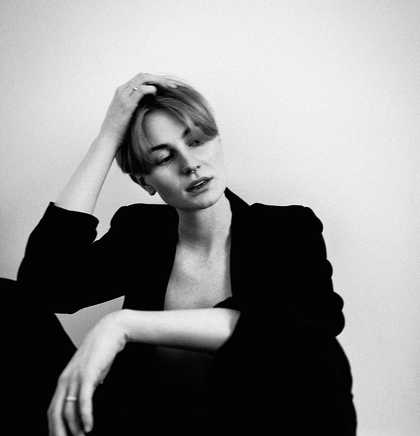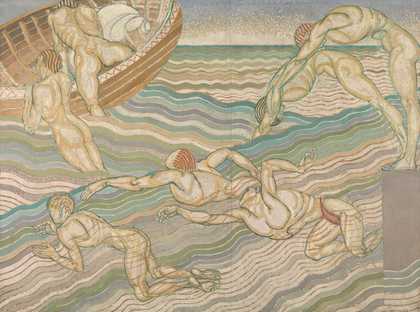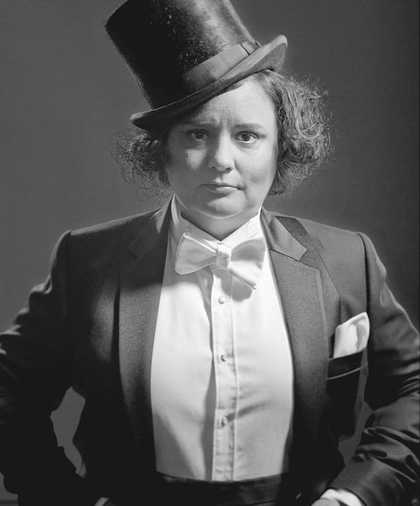Throughout history, the act of sharing artistic practices has been a vital bonding agent for the queer community. Creative cultural events have drawn queer folk together in spaces ranging from pubs to carnivals and in more recent years, into museums.
So when members of the LGBTQIA+ public were invited to co-curate a queer digital exhibition for Tate, it was unsurprising that submissions flooded in from around the world. From Russia to Argentina, Beijing to Brighton, art brought the community together during an intense period of isolation.
No contribution better illustrates how we can use art to form queer bonds across borders, than the submission received from Archivo de la Trans Memoria. In it, they’ve paired Nan Goldin’s 1991 photo of Misty and Jimmy Paulette in a Taxi, NYC, with a remarkably similarly poised photo of two trans women in a taxi during the Buenos Aires’ Carnival in 2000. The shots speak to each other like sisters, offering an endearing reminder of the cultural experiences we share despite our distance. If one good thing has come of Covid-19, it’s how we’ve learned to use digital community curation to bring us closer together.
No wonder, then– when the pandemic forced us to miss each other, our spaces, our music, our fashion, our performance, our talk– the queer community was so enthusiastic about using Tate’s collection as a vehicle to reach out to each other. Queerate Tate made the personal not just political, but possible. This is precisely what national collections are for: to be used by the public, to make sense of the world around us and our place in it.
In keeping with the spirit of Queerate Tate, this final selection of 20 works has been chosen by public vote. It sweeps across three centuries and a variety of mediums.
The contributors’ interpretation is equally as far-reaching, including queer art history, personal testimony, and contemporary political concerns of the community.
By the LGBTQIA+ community, about the LGBTQIA+ community, Queerate Tate is filled with messages of hope, love and survival that offer strength to us all in these most extraordinary times.
– E-J Scott, Curator, Museum of Transology
Banner artwork: Fox Fisher @thefoxfisher
Nan Goldin, Misty and Jimmy Paulette in a Taxi, NYC, 1991 and Archivo de la Memoria Trans, Taxi Girls, Hotel Gondolin, Buenos Aires, 2000
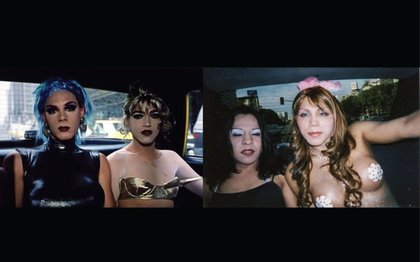
Archivo de la Memoria Trans
Taxi Girls, Hotel Gondolin, Buenos Aires, 2000
In response to Nan Goldin's Misty and Jimmy Paulette in a Taxi, NYC, 1991
Historically, Carnivals have always been the favourite festival of Argentinian trans women. Those two weekends a year, from Friday to Sunday, were the only times our wigs, make-up and heels didn’t make us marginalised criminals. Instead, we are the divas of the neighbourhood parades in both the capital Buenos Aires and in its provinces. We would wait all year long for those precious few days of corsos when we could go out in the streets and be free to be ourselves: to meet, have fun, and wear everything and anything we wanted to.
Queerated by Archivo de la Memoria Trans @archivotrans whose mission is to gather, rescue and archive documentation surrounding the history of the Argentinian trans community.
Peter Sedgley, Colour Cycle III, 1970
To me, 'queer' is not only about a person or a community, it can also be about a place, a feeling, an experience. It can be staring at Colour Cycle III and feeling it stare back at me. I've only been to Tate Modern once, on a wild trip to London with my (by then already) ex-girlfriend. Sedgley's bright, pulsing work stood out to me, encompassing both my own queerness and the queerness of our adventure. When I realised I was gay, my experience of attraction, desire and gender roles became fluid and ever-changing, like Sedgley’s morphing colours. In my eyes, the state of being queer is itself abstract, always in flux and incredibly colourful.
Queerated by Julija Baublinskaitė @gaycookiefairy
Derek Jarman, Blue, 1993

Derek Jarman
Blue (1993)
Tate
It might seem obvious to write about this work, because it explicitly deals with Jarman’s AIDS related illnesses. But when I first stumbled upon it, I didn't know the story behind it. All I saw was the digitally illuminated blue square, but I instantly recognised its queerness by the way it was simultaneously performative and intimate. As a young, Russian lesbian, I don’t understand some of the cultural nuances– Jarman’s tone of voice is too 80s, too Western. But queer expression moves beyond language, like the way we recognise each other’s gaze, voice and movements. When I see the blue light and witness the silence before Jarman’s monologue begins, my body is struck by a sense of a communal queer imagination.
Queerated by Nadia Chernova @nadiametatextual
Yves Klein, IKB 79, 1959
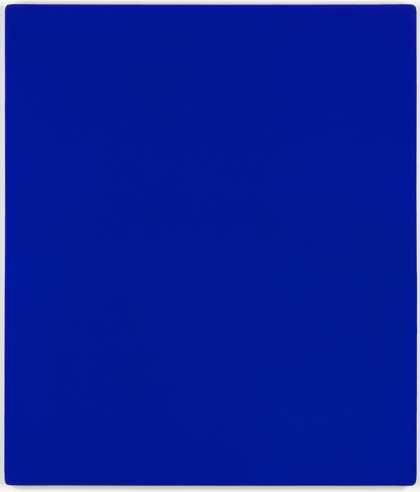
Yves Klein
IKB 79 (1959)
Tate
Yves Klein’s IKB 79 conveys a sense of safety and reassurance that translates into empowerment through its hypnotic, vibrant, blue. The painting has no title constraining the interpretation, no lines, no figures, no composition to examine. You can get lost, find yourself again, empty your head from the noise, disassociate from an oppressive world and maybe even imagine a better one. This blue rectangle is, in this sense, a window to freedom. No labels, no explanations, no hidden meanings, no ‘rights or wrongs’. Herein lies IKB 79’s power and beauty. It just is, and by looking at it, you can just be as well. And it is enough. You are enough.
Queerated by Aurora Fantechi @aurora_fantechi
Zanele Muholi, ID Crisis, 2003
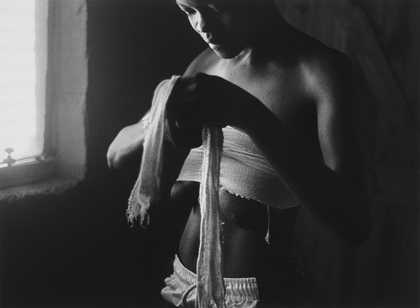
Zanele Muholi
ID Crisis (2003)
Tate
ID Crisis provides us with an intimate glance into the private recesses of LGBTIQ+ life in South Africa. Explorations of the Black trans/queer body are often fetishistic, with the subjects performing their sexuality and pain for the white gaze. Muholi’s series demands a new narrative, where Black LGBTIQ+ community members are the masters of their own intimate truths. The sitters are exposed, yet maintain their dignity. The activist-artist navigates the subject with a sensitivity and understanding that can only exist within projects conceived and produced by members of our own community.
Queerated by QTIPoC Narratives Collective @qtipocnarratives a Brighton-based, grassroots group creating a safe, alternative mental health space for Queer, Trans, Intersex People of Colour to meet, socialise and co-create zines and art.
Andrew Carrick Gow, A Musical Story by Chopin, 1879
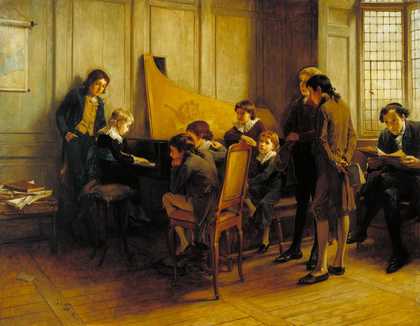
Andrew Carrick Gow
A Musical Story by Chopin (1879)
Tate
A young Chopin plays on the piano with a crowd gathered around him. His father sits by the window. Perhaps they are wondering who this boy will become. Chopin is a Polish national treasure. His name is inscribed on city streets, bottles of vodka, and even the Warsaw airport is named in his honour. So when the recent publication of excerpts from letters that were written in his youth revealed what was possibly homoerotic desire, a public scandal erupted. Despite the content having long been well-known amongst musicologists, it led to hysteria on a national scale amongst Poland’s largely homophobic population.
Was Chopin homosexual? Bisexual? The aim here is not to assign a particular sexual orientation or identity to every figure in history. However, the default assumption that national heroes are automatically presumed to be heterosexual, inevitably leads to the deliberate erasure of queer individuals from the historical record.
Queerated by @KarolRadziszewski from @queerarchivesinstitute, an artist-run organisation dedicated to research, collection, digitalisation, presentation, exhibition, analysis and artistic interpretation of queer archives, with a focus on Central and Eastern Europe.
Street Cleaning Event by Instanbul Queer Art Collective, 2012 and Hi Red Center’s Dropping Event at Ikenobo Hall, Tokyo, October 10, 1964
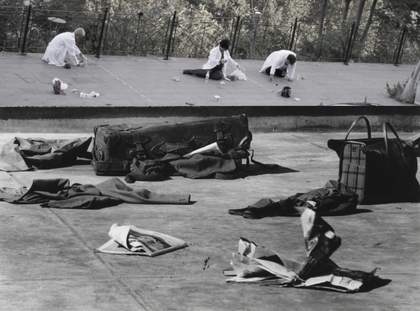
Street Cleaning Event by Istanbul Queer Art Collective, 2012. Photography by Burak Karacan.
In response to Minoru Hirata's Hi Red Center’s Dropping Event at Ikenobo Hall, Tokyo, October 10, 1964
Istanbul Queer Art Collective was founded in 2012 to engage in live art, with a view that the documentation of performance is an art form in and of itself. Our performances range from the durational to the intimate, and can morph towards other forms like sound art or installation. Our first ever performance was a remake of Hi Red Centre’s 1964 Street Cleaning Event. It was one in a series of 'Fluxus Remakes' we created with the intention of queering fluxus performance scores. In the original piece, Hi Red Centre was commenting on the clean national image the government wanted to present during the 1964 Tokyo Olympic Games. In response, we cleaned a street in a queer neighbourhood in Istanbul that the local council had stopped cleaning in preparation for urban development that aimed, among other things, to rid the area of queers.
Queerated by Istanbul Queer Art Collective @queerartprojects @istanbulqueerartcollective
William Blake, The Ghost of a Flea, c.1819–20
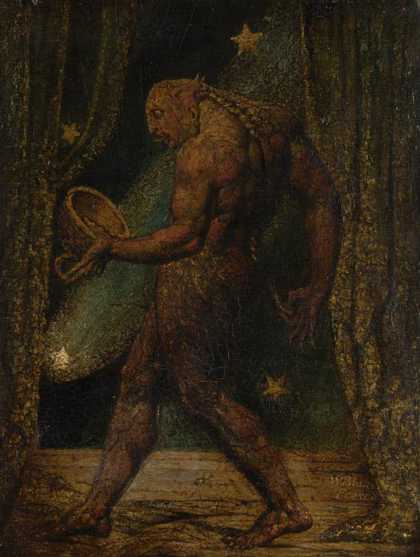
William Blake
The Ghost of a Flea (c.1819–20)
Tate
Queering Space focus on gender, sexuality, migration and decolonial femininisms. In the spirit of Blake's imagination, they created an alternative 'queer origin story' using the invented pronouns voh/vah.
Voh came
crashing down in a basket shaped spaceship with a few other comrades and a tight ass, which was a blessing and a curse. On earth, the oxygen caused vah body to expand – vah fellow fleas have dispersed and now exist in every home. Multiplying, out of control, as if the world was hair. They are your children, your parents, your aunties, khalas, chachas, phuphos, sitos, jhidos, dadis, nanis, dadas, nanas, babas, and more.
Voh is from
nowhere and vah has the whole universe in vah basket; maybe it's a dream.
The belief
is that this nowhere is where all us queers come from. And the Ghost of the Flea protects.
Queerated by Queering Space @queeringspaceart @zulfikaralibhutto @maq39, a critical and anti-racist collaborative initiative operating at the intersections of contemporary art, curation and research.
Huguette Caland, Face to Face, 1971
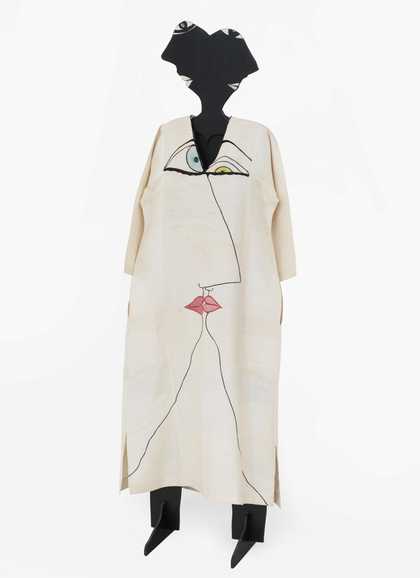
Huguette Caland
Face to Face (1971)
Tate
Face to Face is extraordinarily queer!
Caland’s kaftan physically maps a discussion of bisexuality, intimacy and desire onto the living body underneath. Its abstract faces kiss right over the wearer’s genitalia. It feels inclusive of any number of bodies, yet there’s a contradictory tension in the harmony of the two heads emerging from one pair of shoulders. One looks left, one right. Together, they capture the fluidity of gender expression in the way they are unphased by their ‘twin’.
Pieces like Face to Face allow me to engage in an internal queer dialogue with myself. It challenges me to accept my complexities and to wear them as easily as a kiss on a kaftan.
Queerated by Hannah Ashburn @accio_hannah @ashburnstudios
Akram Zaatari, Bashasha (left) and a friend, 2007
When I found this photo I saved it with the notes 'Women kissing!' I believe it is the only image like this in Tate’s collection. Honestly, it’s not a great kiss – pursed lips, eyes open. Maybe they’re just ‘friends’ (as historians would say – wow, two lifelong best friends who shared a bed and exchanged love letters etc etc). Whatever the reason, I’m glad it exists as evidence in this historic collection that YES women do kiss women, and YES absolutely in Lebanon in the 1950s, and YES we’re going to keep doing it, especially when the camera’s off and the male gaze is fixed elsewhere.
Queerated by Kathy Maniura @kathykathymm a member of Tate's active LGBTIQA+ Staff Network.
Claude Cahun, I Extend My Arms, 1931 or 1932
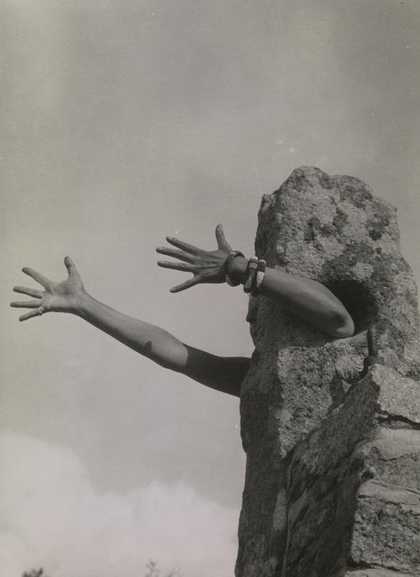
Claude Cahun
I Extend My Arms (1931 or 1932)
Tate
Both Cahun and their life partner were resistance activists who created and distributed anti-Nazi propaganda on the occupied Channel Island of Jersey during the Second World War. They’re the epitome of queerness: resisting oppression in the face of life-threatening violence, trailblazing in the straight man's world of surrealism and producing deeply moving artwork. Cahun stated 'Neuter is the only gender that always suits me,' and when I see their model reaching out of the stone, I see both myself and my trans siblings. To reach out is to not have something, like an absence of fair representation. But to reach out to someone is to offer them support, like tackling trans inequality in the spirit of Cahun’s queer resistance.
Queerated by Dean McColl @damccoll_
Sarah Lucas, NUD CYCLADIC 3, 2010
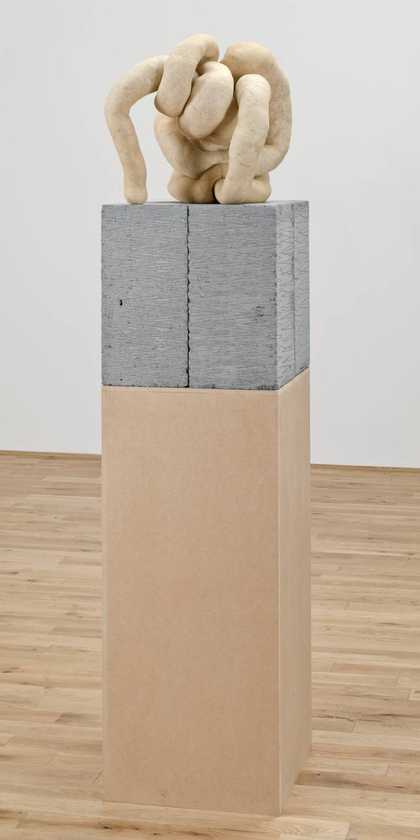
Sarah Lucas
NUD CYCLADIC 3 (2010)
Tate
Watching Sarah Lucas's work change over the years is like watching something being born and come into itself. Like us all, Lucas is constantly grappling with the theatre of gender. She revels in mocking its rules, that are as fascinating as they are ridiculous. Her multiple NUDS– long live their innocent names– have no gender, only flesh. They’ve completely turned in on themselves, an endless lump of self-examination and self-pleasure. Sometimes these little beings may seem nervous, fragile, not knowing what to do. But fear not, NUDS! There's light at the end of the gender tunnel … You need only look up at the horizon.
Queerated by A. Duch Giménez
Charles Ricketts, Illustrations to ‘Daphnis and Chloë’ c.1893
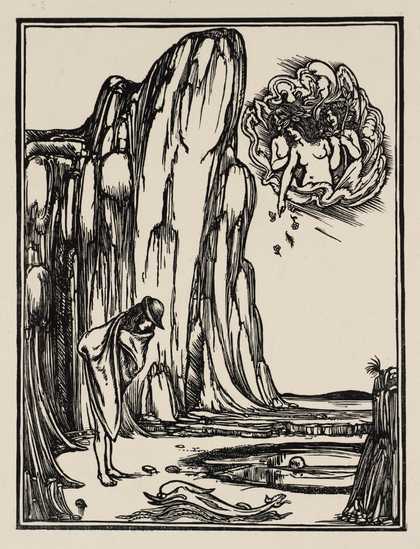
Charles Ricketts
[no title] (c.1893)
Tate
Charles Ricketts’s wood engravings for the ancient Greek novel Daphnis and Chloë were printed by The Vale Press that he managed with his life-partner, Charles Shannon. The couple inhabited a world of unbridled aestheticism.
In 1904, Michael Field (the joint name of the couple Katharine Bradley and Edith Cooper) diarised the couple’s creative intimacy: 'He tells of the joy with which he + Shannon illustrated it … so that Rickett’s design becomes as Shannon’s + Shannon’s as Rickett’s.' A queer and beautiful process that is testament to the dazzling experiments of the late nineteenth century’s aesthetic movement.
Queerated by Frankie Dytor @franks.dytor
Agostino Brunias, Dancing Scene in the West Indies, 1764–96

Agostino Brunias
Dancing Scene in the Caribbean (1764–96)
Tate
This idealised painting by Italian artist Agostino Brunias of life in the West Indies under colonial rule, can be reappropriated to see Black joy in the face of adversity. You can almost smell the Caribbean Sea and hear the laughter and voices of Black women supporting each other. Community is vital to those of us living at the intersection of Black and queer life. Long before LGBTIQ+ people could live outside the shadows, clubs and bars were where we found our chosen family. It’s said that movement is a language within itself, so when LGBTIQ+ Black people get together to party, our bodies move and communicate in ways that are unspoken, yet we all understand. When we dance, we can forget our worries, our stresses, our hardships. We can leave everything out on that dance floor: sharing a collective understanding that Black queer and trans people are lit!
Queerated by Kei Bennett, Founder of AZ Magazine @azmaguk, an online publication dedicated to elevating the voices of LGBTQ+ Black people and People of Colour.
Gerd Winner, Underground Old Street, 1972
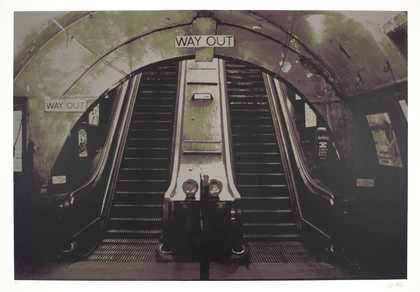
Gerd Winner
Underground Old Street (1972)
Tate
Stuck at home due to COVID, I’m reminded of how desperately important escaping my dreary hometown was for me as a teenager in the early 1990s. Going to London wasn’t only a way of returning to Tate, it was a way of finding out more about my own adult identity. The escape to a densely populated, vibrating and diverse metropolitan community was – as the signs in Winner’s Underground Old Street proclaim – a WAY OUT. Those trips to London shaped and saved me. 25 years on, I still recall the excitement I felt when the Piccadilly line pulled out of Terminals 1–3, passed Hatton Cross, entered Zone 5 and headed on towards Holborn, with Suede playing in my headphones: 'Run with me baby, let’s take a chance. From Heathrow to Hounslow …'
Queerated by Pedro Westerdahl.
Yutaka Takanashi, Tokyo-jin, 1974, printed 2012
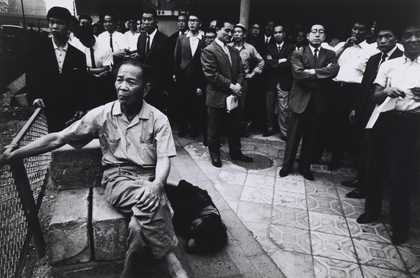
Yutaka Takanashi
Tokyo-jin (1974, printed 2012)
Tate
East Asian men gaze gravely into the distance. Their lingering stares and frowning faces convey a mixture of confusion, worry and disapproval. The metal fence by the elderly man on the left hints at a space out of the men's reach. This elicits the questions: What are they looking at? Who is shutting them out? What is it that threatens these grey men in their cis-het, capitalist, patriarchal uniforms? Our collective has created a space for queer bodies in Asia, so we recognise these men’s disapproving, confounded, defensive expressions. We want to imagine that beyond the fence lie rainbow-coloured queer spaces. For us, the photograph captures the tense limbo between coexistence and separation, a boundary between freedom or space that’s been marked for the outcast.
Queerated by Q-Space @qspacebeijing, a radically inclusive, Beijing-based, feminist, queer space, that collectively organizes non-hierarchical action, considering the dynamic relationship of queer practice with social issues.
Joseph Wright of Derby, Sir Brooke Boothby, 1781
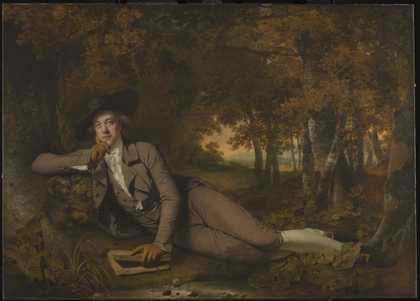
Joseph Wright of Derby
Sir Brooke Boothby (1781)
Tate
We’re drawn to Sir Brooke Boothby’s portrait because the elegant way he reclines (an Elizabethan portraiture tradition) captures our homo-imagination. Boothby appears to be at eye level with the artist Joseph Wright. Though they weren’t gay, the painting’s lethargic energy has captured something that’s both mundane and yet secretive enough to be taking place in the forest. Nowadays, we hear sweeping accusations that men are becoming feminised in the current gender revolution, as opposed to the mythical golden-olden days when men were supposedly more ‘manly’. But for the modern queer viewer, this portrait provides a glimpse of recognition of camp masculinity being performed in the 1700s. Boothby’s title, clothes and book of Rousseau’s philosophy, indicate he was a well-educated man of high status. These credentials are tied up with notions of whiteness and classism, suggesting that campness can only be accepted and understood if expressed through the lens of societal privilege.
Queerated by Glitter Cymru @Glittercymru @RahimAbde_1 and @RaniaVmk, a Wales-based, community social group for People of Colour/ethnic minorities who identify as LGBTQ+.
Robert Delaunay, Endless Rhythm, 1934
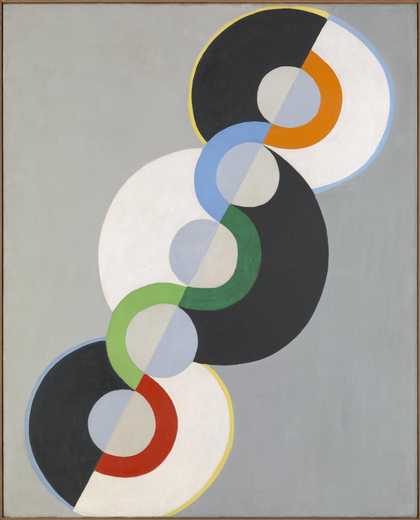
Robert Delaunay
Endless Rhythm (1934)
Tate
The composition of contrasting black and white circles balanced with the coloured arcs, creates a never-ending vector that represents harmony. Each aspect of the composition – from the masculine, almost phallic diagonal straight line to the feminine curves – combines to create an elegantly balanced intermingling of genders in a unified shape. A glorious example of non-binary imagery that illustrates two contrasting design elements coming together to form something altogether beautiful. I think this wonderful piece by Delaunay should inspire unity in a fractured society through its metaphorical depiction of a spectrum of gender identities existing in one body or shape.
Queerated by Ric Leeson @ricleeson
Ugo Rondinone, Liverpool Mountain, 2018
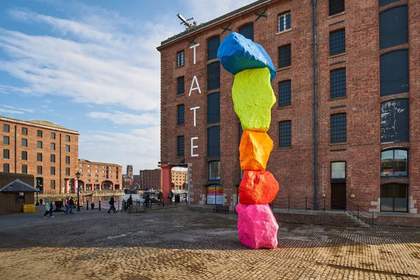
Ugo Rondinone Liverpool Mountain 2018. Photo Rob Battersby
Liverpool Mountain creates a moment of pride within the Albert Docks. Surrounded by the city’s industrial past, the 10-metre high sculpture screams: 'I’m here! I’m queer! Get used to it!' With its ability to cast a rainbow across the cityscape on a gloomy day and shine even brighter on a sunny one, it’s a monument to the place of Queer lives in the everyday. For me, it’s a symbol of defiance, standing tall amidst the macho dockyard buildings. It’s the centre of attention, there for all to see, defying heteronormativity as miraculously as it defies gravity.
Queerated by Lucius Bennison @bennisonsforbeds
Mona Hatoum, Performance Still, 1985, 1995
The past must pass, but still there are things that bind you and pull you back like threads. What you’ve experienced when you were young, the expectations that your environment put on you … It’s all coming back to you … How you were expected to act in a certain way, look normal, be the best version of yourself, prove to yourself and everybody else that you’re a real man. Everything seemed so predetermined. But what once pulled you back, shouldn’t affect your future. No matter how heavy your burden is, no matter how insurmountable your path seems, you can be who you want to be. Untie your laces.
Queerated by Bogdan Shirokov @boshirokov for Centrestage Family, a non-profit project fully dedicated to support LGBTQIA+ artists and curators. Centrestage Family believe showing Russian people a diverse range of art is crucial at a time when 'gay propaganda laws' legislate against LGBTIQ+ people and their families.


